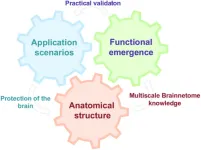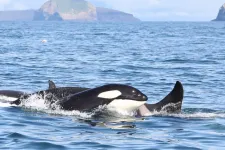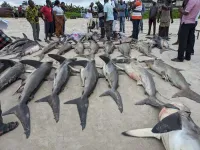Researchers plot a course for building a “digital twin” of the brain
Brain atlases should underpin advanced computer model of human brain
2023-10-11
(Press-News.org)
Recent developments in neuroscience and brain-inspired artificial intelligence have opened up new possibilities in understanding intelligence. Now, a research team led by Tianzi Jiang at the Institute of Automation of the Chinese Academy of Sciences has outlined the key components and properties of an innovative platform called the Digital Twin Brain, which could bridge the gap between biological and artificial intelligence and provide new insights into both. This research was published Sept. 22 in Intelligent Computing, a Science Partner Journal.
Network structure is something that biological and artificial intelligence have in common. Since the brain consists of biological networks, a digital model or “twin” of the brain built using artificial networks would allow researchers to feed knowledge about biological intelligence into the model. The ultimate goal is to “propel the development of artificial general intelligence and facilitate precision mental healthcare,” a feat calling for joint efforts from interdisciplinary scientists worldwide.
Using the Digital Twin Brain, researchers could explore the working mechanisms of the human brain by simulating and modulating the brain in different states for various cognitive tasks. For example, they could simulate how the brain functions properly in a resting state and how it malfunctions in disorders, or develop methods to shift it away from an undesirable state by modulating its activity.
Despite sounding like science fiction, the idea of the Digital Twin Brain stands on solid biological ground. It integrates three core elements: brain atlases serving as the structural scaffolds and biological constraints, multi-level neural models trained on biological data to simulate brain functions, and a spectrum of applications for evaluating and updating the current “twin.”
The three core elements are envisioned to evolve and interact in a closed loop. A dynamic brain atlas leads to improved neural models that generate more realistic function simulations. The current “twin,” consisting of these models, is then validated across an ever-expanding spectrum of practical applications, including disease biomarker discovery and drug tests. These applications complete the cycle by providing feedback to enhance the brain atlas.
The biological brain has intricate structures and complex dynamics. Therefore, highly nuanced brain atlases, including atlases at different scales, of multiple modalities, and even from different species, are needed for learning how to build its digital twin. With a comprehensive collection of atlases, various aspects of the brain, and the connections and interactions between different brain regions, as well as the fundamental principles of brain organization, can be explored in depth.
On the other hand, brain atlases are also constraints in the sense that neural models must be based on them for “biological plausibility,” and that poses technical challenges.
Jiang’s team suggests that the Brainnetome Atlas will be an important component for developing the Digital Twin Brain. Announced by researchers at the Institute of Automation of the Chinese Academy of Sciences in 2016, this atlas is a macroscale atlas encompassing 246 brain sub-regions and has been evolving towards an “extensive and detailed mapping” of the structure and connectivity of the human brain.
Meanwhile, given that existing brain simulation platforms fall short of their anatomical basis, the authors believe it is vital to design “an open-source, efficient, flexible, and user-friendly brain atlas-constrained” platform that is powerful enough to support multiscale and multimodal modeling. There are still many open questions to be addressed, such as how to effectively weave bits and pieces of biological knowledge into a digital twin, how to design better models for simulations, and how to integrate the Digital Twin Brain into practical scenarios.
In summary, the Digital Twin Brain represents a convergence of neuroscience and artificial intelligence. By integrating intricate brain atlases, dynamic neural models, and a multitude of applications, this platform is poised to revolutionize our grasp of both biological and artificial intelligence. With the collective efforts of scientists worldwide, the Digital Twin Brain holds the promise of advancing artificial general intelligence and revolutionizing precision mental healthcare, paving the way for transformative breakthroughs in our understanding of the human mind, the development of intelligent technologies, and the discovering of therapeutics for brain disorders.
END
[Attachments] See images for this press release:


ELSE PRESS RELEASES FROM THIS DATE:
2023-10-11
A groundbreaking study, led by Professor Kyemyung Park and his research team in the Graduate School of Health Science and Technology and the Department of Biomedical Engineering at UNIST has shed light on the intricate mechanism behind the immune system’s ability to differentiate between self and non-self antigens. Their research, published in the esteemed journal Trends in Immunology, presents a novel quantitative framework that could pave the way for predictive models in immune-related disease treatment response.
The immune system is a complex network of cells and molecules that defends ...
2023-10-11
Researchers from Texas Christian University, University of Illinois Urbana-Champaign, and University of Georgia published a new Journal of Marketing article that examines the consumer trend towards minimalist packaging in consumable products.
The study, forthcoming in the Journal of Marketing, is titled “Symbolically Simple: How Simple Packaging Design Influences Willingness to Pay for Consumable Products” and is authored by Lan Anh N. Ton, Rosanna K. Smith, and Julio Sevilla.
Designing products is both an ...
2023-10-11
Both elegant and fierce, killer whales are some of the oceans’ top predators, but even they can be exposed to environmental pollution. Now, in the largest study to date on North Atlantic killer whales, researchers in ACS’ Environmental Science & Technology report the levels of legacy and emerging pollutants in 162 individuals’ blubber. The animals’ diet, rather than location, greatly impacted contaminant levels and potential health risks — information that’s helpful to conservation efforts.
As the largest member of the dolphin family, killer whales, also known as orcas, are ...
2023-10-11
Because metal-organic frameworks (MOFs) — highly porous metal complexes — are so structurally and chemically diverse, they could be used for many applications, such as drug delivery and environmental clean-up. But researchers still need to get a better understanding of how they function, especially when embedded in polymers. Reporting in ACS Applied Materials & Interfaces, researchers have now developed and characterized nitric oxide (NO)-storing MOFs embedded in a thin film with novel antibacterial potential.
Studying ...
2023-10-11
AUSTRALIA, Sydney – October 11, 2023 – Western Sydney University’s NICM Health Research Institute has led a world-first clinical trial in Australia that offers new hope in the treatment of mild cognitive impairment (MCI) among older people. The trial’s results, published in Alzheimer's and Dementia: Diagnosis, Assessment and Disease Monitoring, a journal of the Alzheimer’s Association, signal the efficacy and safety of Sailuotong (SLT), a novel herbal extract, as a potential treatment for MCI.
Trial ...
2023-10-11
Lack of rainfall is not the only measure of drought. New UC Riverside research shows that despite a series of storms, the impact of drought can persist in streams and rivers for up to 3.5 years.
There are two measures of drought in streams. One measure is the total water level, which is impacted by snowmelt and rainfall. Many researchers examine this measurement. Another measure is baseflow, which is the portion of streamflow fed by groundwater.
Fewer researchers examine baseflow droughts, and there was not previously an accurate way to measure them. Because baseflow is strongly tied to groundwater, and because the ...
2023-10-11
Research Highlights:
Chronic kidney disease was strongly associated with an increased risk of sudden cardiac arrest among Hispanic/Latino adults, in a new study.
Early identification and management of kidney disease may reduce risk of sudden cardiac arrest among Hispanic/Latino people, researchers suggest.
Embargoed until 4 a.m. CT/5 a.m. ET Wednesday, Oct. 11, 2023
DALLAS, October 11, 2023 — Chronic kidney disease may increase risk and predict sudden cardiac arrest among Hispanic/Latino adults, according to new research published today in the Journal of the American Heart Association, an open access, peer-reviewed journal of the American ...
2023-10-11
Hispanics and Latinos with chronic kidney disease are at significant risk for suffering from sudden cardiac arrest, according to a new study from the Smidt Heart Institute at Cedars-Sinai.
During sudden cardiac arrest, the heart unexpectedly stops beating.
“Because people who experience sudden cardiac arrest have a survival rate of less than 10%, prevention is extremely important,” said Kyndaron Reinier, Ph.D., associate director of Epidemiology in the Center for Cardiac Arrest Prevention at the Smidt Heart Institute and lead author of the study published in the Journal of the American Heart Association.
“This study highlights the importance for Hispanic ...
2023-10-11
Tens of thousands of endangered sharks and rays are caught by small-scale fisheries off the Republic of the Congo each year, new research shows.
Scientists surveyed fish brought ashore at Songolo, which is home to more than 60% of the country's “artisanal” fishers (small boats, small engines, hand-hauled lines and nets).
In three years, the team – led by the University of Exeter in partnership with the Wildlife Conservation Society (WCS) Congo Program and the Republic of the Congo’s fisheries department – recorded more than 73,000 sharks and rays landed.
Most were juveniles, and 98% of individuals were of species listed as vulnerable, ...
2023-10-11
Named after its habitat preference, Paroedura manongavato, from the Malagasy words “manonga” (to climb) and “vato” (rock), is a bouldering expert. Part of its “home range” is also very well-known to rock climbers for its massive granitic domes. “Its description represents another step into the crux (in climbing jargon, the most difficult section of a bouldering problem) of resolving the taxonomy of the recently revised P. bastardi group, where the new species belongs, and reaching a total of 25 described species in this genus, ...
LAST 30 PRESS RELEASES:
[Press-News.org] Researchers plot a course for building a “digital twin” of the brain
Brain atlases should underpin advanced computer model of human brain







